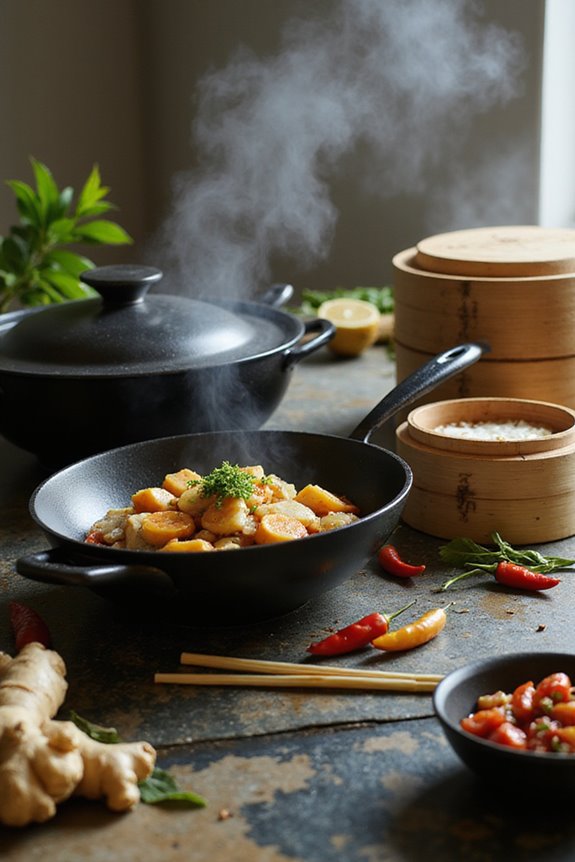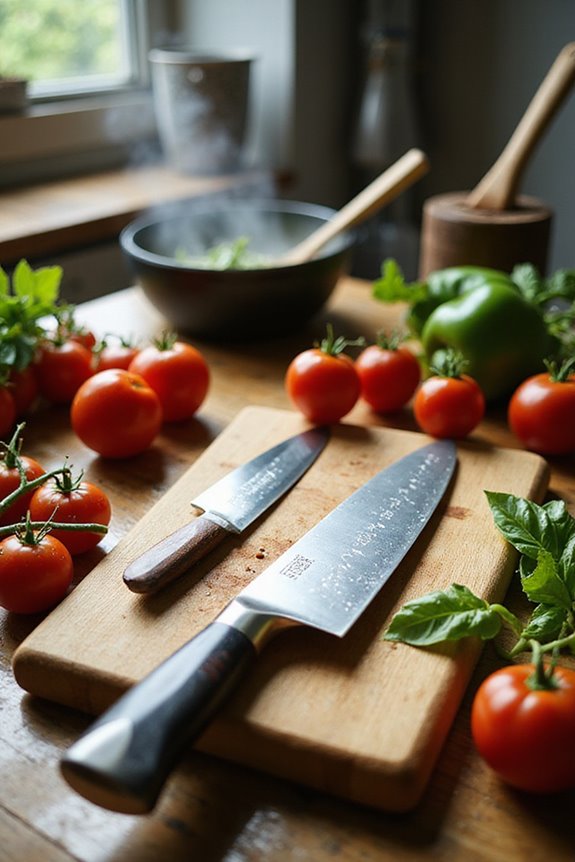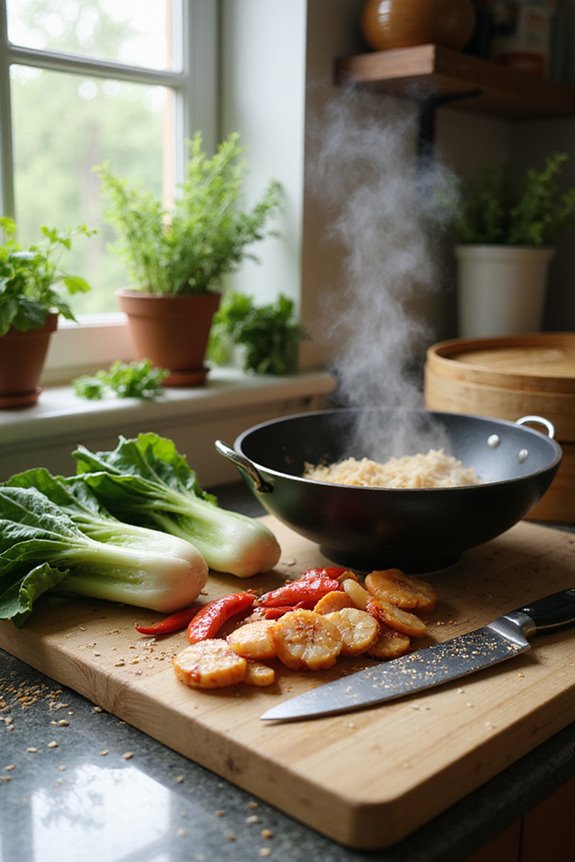As an Amazon Associate, we earn from qualifying purchases. Some links may be affiliate links at no extra cost to you. Although our opinions are based on curated research, we haven't used these products. Articles generated with AI.

10 Best Sushi Cookbooks for Beginners: Your Ultimate Guide to Mastering Sushi at Home
To master sushi at home, check out the ten best sushi cookbooks for beginners. Each offers step-by-step instructions, varied recipes, and practical tips to simplify your sushi-making journey. Look for books with visual aids for easier understanding, ingredient guidance for sourcing quality items, and a balance of traditional and modern recipes. Whether you want quick rolls or elegant sashimi, these cookbooks cater to all skill levels and preferences. You’ll discover invaluable insights to enhance your culinary skills.
Key Takeaways
- Look for cookbooks with diverse recipes, including rolls, nigiri, and options for special dietary needs to enhance your sushi-making experience.
- Ensure the cookbook features clear, step-by-step instructions to effectively guide beginners through sushi preparation techniques.
- Opt for books that include visual aids like photographs or illustrations to help in understanding various sushi-making processes.
- Seek cookbooks that provide practical tips for selecting fresh ingredients and encourage creativity in personalizing recipes.
- Consider your skill level and preferences when choosing a cookbook to ensure a fulfilling and enjoyable sushi-making journey at home.
Sushi Cookbook for Beginners: 100 Step-By-Step Recipes
Sale
Sushi Cookbook for Beginners: 100 Step-By-Step Recipes to Make Sushi at Home
- Ravitch, Chika (Author)
- English (Publication Language)
- 192 Pages - 07/28/2020 (Publication Date) - Callisto (Publisher)
If you’re new to sushi-making and enthusiastic to impress friends and family, the “Sushi Cookbook for Beginners: 100 Step-By-Step Recipes” is an excellent choice for you. This brand-new book, a popular pick among Amazon customers, provides beginner-friendly recipes that let you master sushi at home. With 100 diverse recipes—including gluten-free options—it covers essential techniques, sauces, and types of fish. You’ll find outstanding visuals that guide you through each dish. The glossary also defines key terminology, making it easy to familiarize yourself with sushi tools. Plus, you’ll save money by enjoying sushi right in your kitchen several times a week.
Best For: Beginners looking to learn sushi-making at home with easy, step-by-step recipes and visual guidance.
Pros:
- Comprehensive range of 100 sushi recipes, including gluten-free options.
- Visual aids with outstanding pictures that illustrate finished dishes and techniques.
- Cost-effective solution for families wanting to enjoy sushi multiple times a week without restaurant prices.
Cons:
- Some pictures may only cover basic concepts, limiting visual diversity.
- Limited advanced techniques may not cater to experienced sushi makers.
- Requires sourcing of specific ingredients that may not be readily available in all areas.
The Ultimate Sushi Cookbook for Beginners
The Ultimate Sushi Cookbook for Beginners: A Simple & Easy Step-By-Step Guide to Prepare Deliciously...
- Yanmei, Lei (Author)
- English (Publication Language)
- 102 Pages - 01/05/2023 (Publication Date) - Independently published (Publisher)
“The Ultimate Sushi Cookbook for Beginners” caters primarily to individuals who appreciate a broad collection of sushi recipes but may not require extensive visual guidance. While it offers easy directions for making sushi, sashimi, and nigiri, many users find it lacking in detail. The cookbook’s absence of visual aids means you won’t find pictures to inspire your creations, which can be challenging for beginners who learn best through visuals. For those craving more thorough guidance, alternatives like “Sushi Cookbook for Beginners” by Chika Ravitch provide better options with detailed instructions and helpful images. Consider your needs carefully before purchasing.
Best For: Individuals who enjoy a variety of sushi recipes and don’t need extensive visual aids to guide their cooking.
Pros:
- Offers a broad collection of easy-to-follow sushi recipes.
- Affordable option for those looking to explore sushi-making.
- Variety of dishes including sushi, sashimi, and nigiri.
Cons:
- Lacks visual aids, making it difficult for beginners to visualize the finished dishes.
- Minimal detail and guidance on techniques for novice cooks.
- Considered a poor investment by users seeking comprehensive instructions and support.
Simple Sushi Cookbook for Beginners
Simple Sushi Cookbook For Beginners: A Step-by-Step Guide That Teaches You The Autentic Art For...
- Amazon Kindle Edition
- Harper, Samuel N. (Author)
- English (Publication Language)
For anyone enthusiastic to plunge into the art of sushi-making, the “Simple Sushi Cookbook for Beginners” stands out as an essential resource. With over 100 diverse recipes, it encourages you to step confidently into your sushi journey. This cookbook is perfect for those new to sushi or looking for affordable, practical tips to recreate their favorite rolls at home. You’ll appreciate the clear instructions and user-friendly layout, making each recipe accessible and enjoyable. Highlights include popular choices like California rolls, urging you to experiment with flavors while mastering authentic techniques. Get ready to impress family and friends with your newly acquired skills!
Best For: Sushi lovers and beginners who want affordable and practical guidance for making sushi at home.
Pros:
- Clear and easy-to-follow instructions make sushi-making accessible for novices.
- Over 100 diverse recipes encourage creativity and experimentation in sushi preparation.
- Provides authentic techniques, allowing readers to create restaurant-quality sushi at home.
Cons:
- May be too basic for experienced sushi enthusiasts looking for advanced techniques.
- Limited focus on specialty sushi types outside of popular rolls.
- Requires access to specific ingredients, which may not be readily available to all users.
Sushi Made Easy: The Perfect Beginners Guide
Sushi Made Easy: The Perfect Beginners Guide (Sushi recipes, sushi for beginners, sushi guide,...
- Amazon Kindle Edition
- Saint, Jessi (Author)
- English (Publication Language)
Sushi Made Easy stands out as the perfect guide for those new to sushi-making, offering a welcoming entry point into this culinary craft. This book covers the foundational knowledge you need, including a brief history of sushi and essential food preservation techniques. You’ll find detailed sections outlining necessary tools and ingredients, making your shopping straightforward and stress-free. Clear instructions and helpful tips guide you through various recipes, allowing you to experiment with flavors confidently. Though some photos may be lacking, the organized layout guarantees you can easily follow along, transforming your kitchen into a sushi-making haven in no time.
Best For: Beginners who want to learn the basics of sushi-making in a straightforward and accessible way.
Pros:
- Covers foundational knowledge, including the history of sushi and food preservation techniques.
- Provides clear instructions and helpful tips to enhance the sushi-making experience.
- Encourages experimentation with flavors, instilling confidence in novice chefs.
Cons:
- Scarcity of photographs may hinder visual understanding of techniques.
- Limited quantity of recipes, which might not satisfy those seeking a broader variety.
- Lack of color photos could detract from the visual appeal and instructional clarity.
Sushi Cookbook for Beginners: Easy & Delicious Recipes
Sushi Cookbook for Beginners: Easy & Delicious Sushi Recipes Dive You into the World of Sushi Making...
- Carpenter, Dorothy (Author)
- English (Publication Language)
- 101 Pages - 07/11/2024 (Publication Date) - Independently published (Publisher)
If you’re new to the world of sushi and feeling a bit overwhelmed, the “Sushi Cookbook for Beginners: Easy & Delicious Recipes” is the perfect choice for you. This invaluable resource offers clear instructions and helpful photographs, making sushi-making accessible to all skill levels. With over 1000 recipes, you’ll explore basic rolls, sushi bowls, nigiri, and even sashimi. The author emphasizes practical tips for ingredient sourcing and substitutions. You’ll appreciate the calorie information accompanying each dish, especially if you’re watching your diet. This cookbook is not just a guide; it’s a confidence booster for your sushi journey at home.
Best For: Beginners looking to explore sushi-making in a simplified and enjoyable way.
Pros:
- Clear instructions and helpful photographs guide readers through the sushi-making process.
- Over 1000 recipes encompass a variety of sushi types, catering to different tastes and preferences.
- Practical tips for sourcing ingredients and calorie information support health-conscious cooking.
Cons:
- Limited visuals and advanced techniques may leave experienced cooks wanting more.
- The paperback format and black and white pages may not appeal to everyone.
- Some readers wish for more in-depth explanations on certain sushi-making techniques.
Sushi Cookbook for Beginners: A Comprehensive Guide to Mastering Sushi at Home
Sushi Cookbook for Beginners: A Comprehensive Guide to Ingredients, Techniques, and Easy Recipes for...
- Shelton, Victor (Author)
- English (Publication Language)
- 115 Pages - 11/27/2024 (Publication Date) - Independently published (Publisher)
Access the world of homemade sushi with “Sushi Cookbook for Beginners,” ideal for anyone enthusiastic to plunge into this culinary adventure. This all-encompassing guide by Victor Shelton helps you grasp the essential elements of sushi making, from selecting high-quality ingredients to mastering sushi rice preparation. You’ll appreciate the clear, accessible instructions that make the process enjoyable for everyone, including families wanting to cook together. With a variety of recipes focusing on classic rolls and nigiri, you’re encouraged to customize dishes to fit your tastes. Users report significant improvements in their skills and satisfaction from sharing delicious sushi creations at home.
Best For: Beginners and families looking to explore the art of sushi making at home with clear instructions and customizable recipes.
Pros:
- Clear and easy-to-follow instructions make it accessible for first-time sushi makers.
- Encourages customization of recipes to suit personal preferences, catering to diverse tastes.
- Provides valuable insights and techniques that significantly improve sushi-making skills over time.
Cons:
- May lack advanced techniques and recipes for experienced sushi chefs looking for more challenging options.
- Ingredient availability could be a limitation depending on local markets.
- Some users might desire more cultural context or history about sushi and its variations.
Sushi Cookbook For Beginners: Authentic Techniques for Delicious Homemade Sushi
Sushi Cookbook For Beginners: The most comprehensive guide that teaches you the authentic techniques...
- Amazon Kindle Edition
- Dai Mori, Asai (Author)
- English (Publication Language)
For anyone enthusiastic to learn the art of sushi-making at home, “Sushi Cookbook For Beginners: Authentic Techniques for Delicious Homemade Sushi” stands out as an ideal choice. This cookbook offers essential guidance on selecting quality ingredients, particularly rice and fresh fish, along with slicing techniques you’ll find invaluable. Even though some reviewers noted a lack of color photos and clear images, the content’s strength lies in its practical advice. You’ll appreciate the focus on healthy preparation methods, ensuring you minimize risks of contamination. Many users have successfully experimented with the recipes, making this book a great starting point for creating your own sushi.
Best For: Beginner home cooks who are eager to learn authentic sushi-making techniques with practical guidance.
Pros:
- Comprehensive instructions on essential ingredients and sushi-making techniques for novices.
- Emphasis on health and safety, with detailed instructions on food handling to minimize risks.
- Successful experimentation reported by users, making it a strong foundation for home sushi preparation.
Cons:
- Lack of color photos, which could enhance the instructional experience and visual appeal.
- Blurry images that may detract from understanding techniques and presentations.
- Desire for more step-by-step photos, as many reviewers suggested that clearer instructions would benefit the learning process.
Sushi Cookbook for Beginners: Easy Recipes and Expert Tips
No products found.
Looking to immerse yourself in the delicious world of sushi? The “Sushi Cookbook for Beginners” is your perfect companion. It features easy-to-follow recipes for rolls, sashimi, and nigiri, complete with clear photos and concise explanations. You’ll appreciate the beginner-friendly instructions that simplify sushi-making, ensuring a smooth experience. With essential techniques and expert tips, like achieving perfect rice consistency and slicing fish for sashimi, you’ll see significant improvement in your skills. The book also guides you on selecting quality ingredients and necessary equipment, expanding your knowledge while you experiment with a variety of exciting recipes. Immerse yourself—your sushi journey awaits!
Best For: Those who are new to sushi-making and want a comprehensive guide to create delicious sushi at home.
Pros:
- Clear photos and concise explanations make it beginner-friendly.
- Includes essential techniques and expert tips to enhance skills.
- Offers a variety of recipes, encouraging experimentation with sushi-making.
Cons:
- May lack advanced recipes for more experienced sushi chefs.
- Sourcing specific ingredients might be challenging in some areas.
- Some techniques may require practice to master fully.
Complete Guide to Sushi and Sashimi
Sale
The Complete Guide to Sushi and Sashimi: Includes 625 step-by-step photographs
- Elliot, Jeffrey (Author)
- English (Publication Language)
- 306 Pages - 10/09/2015 (Publication Date) - Robert Rose (Publisher)
When you want to plunge into sushi-making, “The Complete Guide to Sushi and Sashimi” stands out as the best choice for beginners and experienced cooks alike, thanks to its exceptional design and user-friendly features. This cookbook boasts 625 step-by-step photographs, making it easy to follow each instruction. The spiral binding allows it to lay flat, so you won’t struggle to keep pages open. You’ll find a wide range of recipes, from basic rolls to advanced techniques, catering to various skill levels. Jeffrey Elliot’s accessible approach encourages creativity while fostering a supportive community for sushi enthusiasts. It’s an indispensable resource!
Best For: This cookbook is best for both beginners looking to learn sushi-making and experienced cooks wanting to refine their skills.
Pros:
- Extensive Visual Guidance: 625 step-by-step photographs that make following recipes straightforward.
- User-Friendly Design: Spiral binding allows the book to lay flat, enhancing the cooking experience.
- Versatile Recipes: Offers a range of recipes from basic to advanced, catering to various skill levels and preferences.
Cons:
- Limited Ingredient Availability: Some specialty ingredients may be challenging to find for beginners.
- Potential Overwhelming Options: The wide range of recipes and techniques might overwhelm novice cooks.
- Price Point: The cost may be higher compared to other sushi cookbooks on the market.
Sushi for Beginners: A Complete Sushi Guide
Sushi for Beginners: A Complete Sushi Guide for Beginners!Discover Features, Basics and How to Make...
- Amazon Kindle Edition
- Nishimura, Osami (Author)
- English (Publication Language)
Sushi for Beginners: A Complete Sushi Guide serves as an excellent choice for anyone new to sushi-making, especially those who appreciate straightforward instructions without overwhelming complexity. This book offers a helpful overview of traditional Japanese sushi compared to Western variations and details essential rice cooking techniques. Although the recipes are simple and easy to follow, some readers find the limited variety somewhat disappointing. The book suffers from a lack of visual appeal, featuring minimal illustrations and a rather unprofessional layout. Overall, while it can inspire home sushi preparation, consider exploring other options for more engaging content.
Best For: Beginners who want to learn the basics of sushi-making with straightforward instructions and essential rice cooking techniques.
Pros:
- Simple and easy-to-follow recipes suitable for novices.
- Provides a helpful overview of traditional Japanese sushi versus Western variations.
- Inspires home sushi preparation despite its limitations.
Cons:
- Limited variety of recipes may disappoint some readers.
- Lacks visual appeal, featuring only black and white print with minimal illustrations.
- Unprofessional layout resembles a child’s book, detracting from the overall experience.
Factors to Consider When Choosing a Sushi Cookbook Beginner Guide

When you’re picking a sushi cookbook, think about recipe variety and how complex they are. Also, check if there are enough visual aids and clear instructions to guide you through each step. Don’t forget to take into account the equipment, ingredient guidance, and practical tips that can really enhance your sushi-making experience.
Recipe Variety and Complexity
Choosing the right sushi cookbook can feel overwhelming, especially for beginners enthusiastic to plunge into the culinary world of this beloved Japanese dish. Look for a book that features a variety of recipes, including sushi rolls, nigiri, and sashimi, to keep things interesting. Step-by-step instructions are essential; they help you navigate each recipe with confidence. Make sure the complexity aligns with your skill level, focusing on accessible ingredients and techniques. Also, consider cookbooks that offer gluten-free or vegetarian options to cater to dietary needs. Practical tips and variations within the recipes can spark your creativity and encourage experimentation, making your sushi-making journey both fun and educational.
Visual Aids and Photography
Visual aids play a significant role in your sushi-making journey, especially as a beginner. Well-placed photographs help you visualize the finished dishes, making it easier to grasp essential techniques. If a cookbook lacks sufficient images, you might find yourself frustrated when tackling complex rolling methods. Step-by-step photos provide invaluable examples, guiding you through each stage of sushi preparation. Bright, vibrant images not only enhance engagement but also spark your creativity in the kitchen. When you face common issues, having detailed visuals to reference can be a lifesaver. Consequently, when selecting a sushi cookbook, prioritize those rich in imagery to guarantee your learning experience is both enjoyable and effective. After all, a picture is worth a thousand rolls!
Instructions and Clarity
Sushi-making can initially feel challenging, but a well-structured cookbook can make a world of difference. Look for cookbooks that offer clear, step-by-step instructions; this is essential for beginners unfamiliar with sushi techniques. Good cookbooks provide practical advice that enhances your learning experience, making the process smoother. Choose books that detail vital techniques like slicing fish for sashimi and shaping nigiri, as these are fundamental skills you’ll need. Additionally, guarantee the cookbook includes thorough ingredient lists alongside straightforward directions, which cater to those new to sushi prep. Finally, consider options that break down complex concepts into simpler terms; this will build your confidence and understanding while making your sushi-making journey enjoyable.
Equipment and Ingredient Guidance
Finding the right equipment and ingredients plays a significant role in your sushi-making journey. Look for a cookbook that emphasizes high-quality, sushi-grade fish and specific rice types, essential for authentic flavor. Also, a thorough guide should outline essential tools like a bamboo mat, a sharp knife, and a rice cooker. Clear instructions on cooking and seasoning sushi rice are critical, as this component largely influences your dish’s success. Some cookbooks offer substitution options for hard-to-find ingredients, making sourcing easier. Additionally, understanding food safety practices is important, particularly when handling raw fish and perishables. Always prioritize these factors to guarantee your sushi turns out delicious and safe to eat, making your culinary experience enjoyable.
Practical Techniques and Tips
When you’re selecting a sushi cookbook for beginners, it’s crucial to prioritize those that offer detailed guidance on practical techniques and tips. Look for books that clearly explain essential skills like rice preparation, fish slicing, and rolling methods, which help you build a solid foundation in sushi-making. You’ll also want cookbooks that provide practical advice on sourcing ingredients, including substitutions for hard-to-find items. Make sure the guide includes expert tips on using tools like sushi mats and getting the rice consistency just right. A good cookbook will break down complex processes into easy-to-follow steps, making your learning experience smoother. Finally, choose recipes that encourage experimentation, allowing you to adapt dishes to suit your personal tastes.
Target Audience Consideration
A well-chosen sushi cookbook can make a huge difference in your culinary journey as a beginner. Look for one that offers clear and simple instructions, ensuring you can easily follow along. A glossary defining key terminology and tools is also invaluable, helping you grasp sushi fundamentals. It’s wise to select a cookbook featuring a variety of recipes, including gluten-free options, to suit different dietary preferences and inspire culinary experimentation. Visual aids like photographs and step-by-step images can guide you in visualizing the finished dishes and techniques. Additionally, consider the overall user experience; a readable font and intuitive layout will enhance your learning, especially when your hands might get a little messy during the cooking process.
Cost-Effectiveness and Value
Cost-effective sushi cookbooks offer impressive savings for families enthusiastic to enjoy sushi regularly without overspending at restaurants. When you choose a cookbook, look for one that features over 100 recipes; this variety gives you the chance to explore different sushi types and techniques while avoiding the need for multiple purchases. Additionally, cookbooks that emphasize affordable ingredient sourcing and substitutions make it easier to whip up your favorite rolls, even when certain items are difficult to find. A well-priced book with detailed instructions helps reduce mistakes, saving you both time and ingredients. Ultimately, investing in a quality sushi cookbook equips you with skills that allow you to create delicious homemade sushi, lessening your reliance on takeout and dining out.
Frequently Asked Questions
What Tools Are Essential for Making Sushi at Home?
To make sushi at home, you’ll need a few essential tools. A bamboo sushi mat is vital for rolling your sushi evenly. A sharp knife helps slice the rolls cleanly, while a rice cooker simplifies perfect sushi rice preparation. You’ll also want a mixing bowl for the rice and a cutting board. Don’t forget sushi-grade fish and fresh vegetables; they’re key to achieving that authentic taste and texture you’re aiming for in your homemade sushi.
Can I Substitute Ingredients for Sushi Recipes?
Yes, you can substitute ingredients in sushi recipes! Think of it like painting—experimenting with colors can create something unique. Instead of traditional sushi rice, you could use quinoa or brown rice. For fillings, avocado can replace fatty fish, while cucumber and carrots add crunch. Just remember that flavor and texture may shift. Be mindful of your substitutions to keep balance and enjoy the creative process that comes with customizing your sushi!
How Do I Store Leftover Sushi Properly?
To store leftover sushi properly, wrap each piece in plastic wrap to prevent moisture loss and preserve freshness. Place the wrapped sushi in an airtight container, ensuring it’s secure. Keep it in the refrigerator, ideally consuming it within 24 hours for the best taste and texture. Avoid freezing sushi, as it can compromise the quality. When you’re ready to eat, let it come to room temperature for peak flavor.
Is Homemade Sushi Healthier Than Restaurant Sushi?
Homemade sushi can be healthier than restaurant sushi, as you control the ingredients and portion sizes. You can use fresh vegetables, high-quality fish, and less sodium in your sushi rolls. Plus, when you make it at home, you avoid potential additives and preservatives often found in restaurant sushi. Just be sure to follow food safety guidelines for handling raw fish, and use reputable sources for your ingredients to maximize health benefits.
How Long Does It Take to Master Sushi Making?
How long does it take to master sushi making? Well, it often takes a few months of practice to become proficient. You’ll start with simple rolls and gradually tackle more complex techniques. Regular practice, along with watching tutorials and experimenting with ingredients, helps speed up your learning. Patience is key, though—every chef develops at their own pace. So jump in, practice consistently, and soon you’ll impress yourself with your sushi-making skills.













